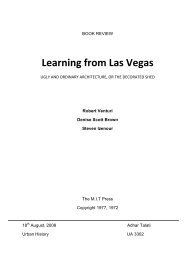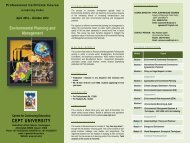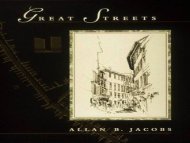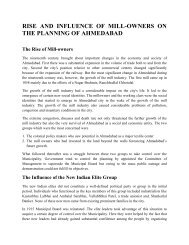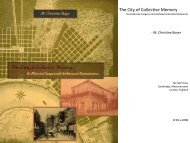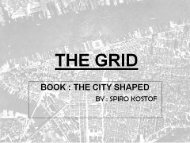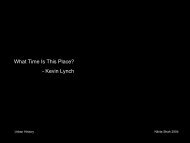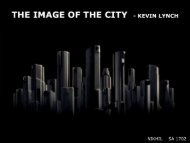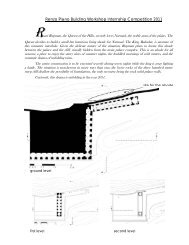The Death and Life of Great American Cities, by Jane Jacobs
The Death and Life of Great American Cities, by Jane Jacobs
The Death and Life of Great American Cities, by Jane Jacobs
Create successful ePaper yourself
Turn your PDF publications into a flip-book with our unique Google optimized e-Paper software.
<strong>The</strong> <strong>Death</strong> <strong>and</strong> <strong>Life</strong> <strong>of</strong> <strong>Great</strong> <strong>American</strong> <strong>Cities</strong><br />
Published 1961<br />
Author: <strong>Jane</strong> <strong>Jacobs</strong> 1916-2006, <strong>American</strong>-born Canadian urbanist.<br />
Along with her well-known printed works, <strong>Jacobs</strong> is equally well known for organizing grassroots<br />
efforts to block urban-renewal projects that would have destroyed local neighborhoods.<br />
“Streets in cities serve many purposes besides carrying vehicles, <strong>and</strong> city sidewalks serve<br />
many purposes besides carrying pedestrians.” <strong>by</strong> <strong>Jane</strong> <strong>Jacobs</strong><br />
If one thinks <strong>of</strong> a city, streets come to mind. And if the streets look interesting the city does so<br />
too, if not, neither does the city. And if the streets are considered safe so is the city.<br />
But if a city or a part <strong>of</strong> it is considered dangerous, the people don‘t feel safe on their streets<br />
<strong>and</strong> sidewalks <strong>and</strong> use them less which makes them even more unsafe.
<strong>Great</strong> cities aren't just towns, on<br />
a bigger scale <strong>and</strong> with a higher<br />
density.<br />
One out <strong>of</strong> several designative<br />
points is that a city is full <strong>of</strong><br />
strangers.<br />
And somehow one needs to get<br />
a feeling <strong>of</strong> safety among all <strong>of</strong><br />
them.<br />
<strong>The</strong> insecurity <strong>and</strong> barbarism<br />
isn't a slum bound problem, it's<br />
rather a serious mater <strong>of</strong> quite<br />
residential areas.<br />
It doesn't appear more <strong>of</strong>ten in<br />
places where minority groups <strong>and</strong><br />
the poor live.<br />
In New York those sidewalks are<br />
considered one <strong>of</strong> the safest, <strong>by</strong><br />
day <strong>and</strong> night.<br />
Lower East New York 1909
One can say that well used<br />
streets are also safe streets,<br />
<strong>and</strong> that ab<strong>and</strong>oned streets are<br />
to be unsafe.<br />
But how does that work?<br />
Lower East New York 1909
In a city privacy is something<br />
personal, oneself can choose<br />
how much one will tell or not tell,<br />
its not like in a small town where<br />
everyone knows ones matters.<br />
So privacy will be carefully guarded.<br />
And it has to been chosen<br />
between privacy <strong>and</strong> the contact<br />
necessary between people.<br />
In good city-street adjacencies<br />
privacy <strong>and</strong> contact are in balance<br />
allowing the community to<br />
work.<br />
Lower East New York
In some areas where sidewalks<br />
don‘t exist people have to enlarge<br />
their private space to<br />
have contact with their neighborhood<br />
<strong>and</strong> loose so more<br />
<strong>of</strong> their privacy, as when there<br />
would be a sidewalk to use for<br />
those proposes.<br />
Where people share so much<br />
privacy they get picky about<br />
who they want to share it with,<br />
so they start to isolate themselves.<br />
Like this privacy <strong>and</strong> contact<br />
start to fall out <strong>of</strong> balance.<br />
Chatham Village, Pittsburgh
Some planing ideas want to<br />
emphasize the contact, the togetherness,<br />
among the people<br />
<strong>and</strong> force them almost into contact<br />
<strong>and</strong> sharing.<br />
But this divides cities more than<br />
tying them together.<br />
<strong>The</strong>re must be a clear boundary<br />
between public <strong>and</strong> private<br />
space.<br />
Suberben area Pittsburgh
An other misbelieve <strong>by</strong> city reformers<br />
is that people hanging<br />
around the street corners increases<br />
the street insecurity.<br />
“ ...If these people had decent<br />
homes <strong>and</strong> more private<br />
or bosky outdoor places, they<br />
wouldn‘t be on the streets.”<br />
According to the author this is<br />
a terrible misunderst<strong>and</strong>ing <strong>of</strong><br />
cities.<br />
Insecurity can‘t be salved <strong>by</strong><br />
spreading people more thinly.<br />
Gathering areas are important<br />
for cities, they bring together<br />
strangers, <strong>and</strong> there comes up<br />
a feeling <strong>of</strong> “community”, a presence<br />
<strong>of</strong> casual public trust.
An other misbelieve <strong>by</strong> city reformers<br />
is that people hanging<br />
around the street corners increases<br />
the street insecurity.<br />
“ ...If these people had decent<br />
homes <strong>and</strong> more private<br />
or bosky outdoor places, they<br />
wouldn‘t be on the streets.”<br />
According to the author this is<br />
a terrible misunderst<strong>and</strong>ing <strong>of</strong><br />
cities.<br />
Insecurity can‘t be salved <strong>by</strong><br />
spreading people more thinly.<br />
Gathering areas are important<br />
for cities, they bring together<br />
strangers, <strong>and</strong> there comes up<br />
a feeling <strong>of</strong> “community”, a presence<br />
<strong>of</strong> casual public trust.<br />
Ahmedabad
<strong>The</strong>re must be eyes on the<br />
street, meaning that inhabitants<br />
<strong>and</strong> owners get involved what<br />
is happing on the street. People<br />
who notice what goes on in<br />
the streets <strong>and</strong> which can take<br />
action if necessary.<br />
It is important that the eyes<br />
which watch a street can generate<br />
a feeling <strong>of</strong> trust to the<br />
people on the streets, in order<br />
for the community surveillance<br />
to work, to know if that guy is<br />
just hanging around or if he<br />
seems to have bad intentions.<br />
This trust gets built up <strong>by</strong> many<br />
small social activities which<br />
happen in a community, which<br />
build a community identity.<br />
This is something that can not<br />
be provided <strong>by</strong> an institution,<br />
these contacts have to come<br />
from the people.
<strong>The</strong>re must be eyes on the<br />
street, meaning that inhabitants<br />
<strong>and</strong> owners get involved what<br />
is happing on the street. People<br />
who notice what goes on in<br />
the streets <strong>and</strong> which can take<br />
action if necessary.<br />
It is important that the eyes<br />
which watch a street can generate<br />
a feeling <strong>of</strong> trust to the<br />
people on the streets, in order<br />
for the community surveillance<br />
to work, to know if that guy is<br />
just hanging around or if he<br />
seems to have bad intentions.<br />
This trust gets built up <strong>by</strong> many<br />
small social activities which<br />
happen in a community, which<br />
build a community identity.<br />
This is something that can not<br />
be provided <strong>by</strong> an institution,<br />
these contacts have to come<br />
from the people.
<strong>The</strong>re must be eyes on the<br />
street, meaning that inhabitants<br />
<strong>and</strong> owners get involved what<br />
is happing on the street.<br />
People who notice what goes<br />
on in the streets <strong>and</strong> which can<br />
take action if necessary.<br />
It is important that the eyes<br />
which watch a street can generate<br />
a feeling <strong>of</strong> trust to the<br />
people on the streets, in order<br />
for the community surveillance<br />
to work, to know if that guy is<br />
just hanging around or if he<br />
seems to have bad intentions.<br />
This trust gets built up <strong>by</strong> many<br />
small social activities which<br />
happen in a community, which<br />
build a community identity.<br />
This is something that can not<br />
be provided <strong>by</strong> an institution,<br />
these contacts have to come<br />
from the people.
Sidewalks should have continuously<br />
users on it.<br />
So a mixture <strong>of</strong> residential <strong>and</strong><br />
commercial would be wise.<br />
Like this the city doesn‘t become<br />
ab<strong>and</strong>oned at day or<br />
night.<br />
Also important is that public<br />
peace <strong>of</strong> cities isn‘t kept primarily<br />
<strong>by</strong> the police, its kept <strong>by</strong> the<br />
people themselves.
Conclusion<br />
Fist, there must be a clear boundary between public <strong>and</strong> private space.<br />
Secondly, there must be eyes on the street, meaning that inhabitants <strong>and</strong> owners get involved<br />
what is happing on the street <strong>and</strong> take action if necessary.<br />
Thirdly, the sidewalks should have continuously users on it.



